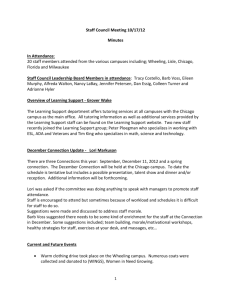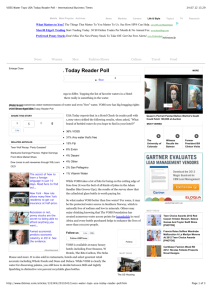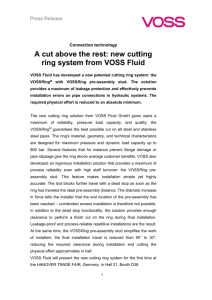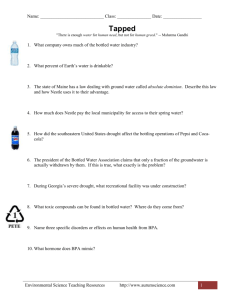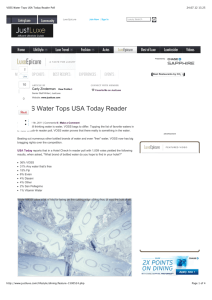File - Mass Comm Works
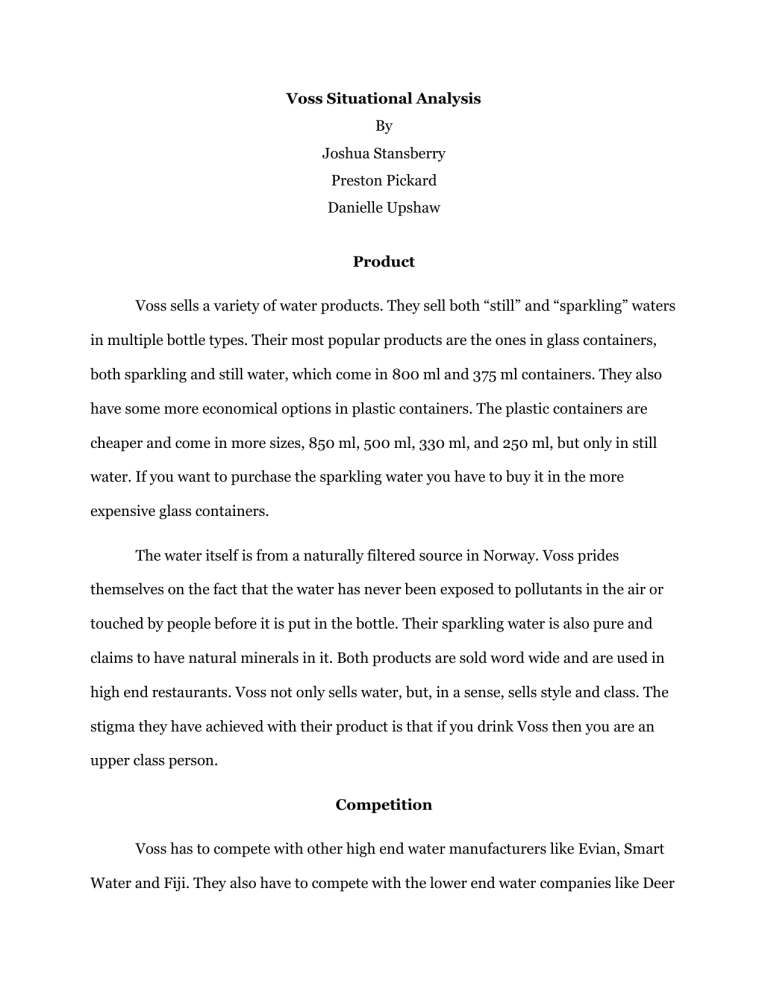
Voss Situational Analysis
By
Joshua Stansberry
Preston Pickard
Danielle Upshaw
Product
Voss sells a variety of water products. They sell both “still” and “sparkling” waters in multiple bottle types. Their most popular products are the ones in glass containers, both sparkling and still water, which come in 800 ml and 375 ml containers. They also have some more economical options in plastic containers. The plastic containers are cheaper and come in more sizes, 850 ml, 500 ml, 330 ml, and 250 ml, but only in still water. If you want to purchase the sparkling water you have to buy it in the more expensive glass containers.
The water itself is from a naturally filtered source in Norway. Voss prides themselves on the fact that the water has never been exposed to pollutants in the air or touched by people before it is put in the bottle. Their sparkling water is also pure and claims to have natural minerals in it. Both products are sold word wide and are used in high end restaurants. Voss not only sells water, but, in a sense, sells style and class. The stigma they have achieved with their product is that if you drink Voss then you are an upper class person.
Competition
Voss has to compete with other high end water manufacturers like Evian, Smart
Water and Fiji. They also have to compete with the lower end water companies like Deer
Park and Dasani. Because they are not just a water manufacturer but technically a drink manufacturer, they also have to compete with companies like coke, Pepsi, and Snapple.
One thing that Voss has over their competitors, though, is that their glass bottles are easily reusable. You can even wash them. You can’t do that as easily with the plastic bottles other companies use.
Market Trends
Voss water is a very high end artesian water bottled in Norway. There are several market trends that affect the sale of bottled water. According to
Foodmanufacturing.com these are exciting times to be in the bottled water business.
Sales and consumption have continued to grow and they expect this to continue. 2013 data from Beverage Marketing Corporation shows United States bottled water consumption up 4.3% from 2012 at 10.1 billion gallons consumed. The Average
American drinks 31.8 gallons of bottled water a year. Bottled water sales increased 4.1% putting it at $12.3 billion total.
There are many reasons that point to the total growth in this industry. Health awareness, convenience, safety, and value are a few of these. Health awareness has been growing since the early 2000s. With social media picking up every second of life, people want to look and feel their best. With the economy in a recession, value is not only being trendy, it’s being smart. Market trends can be new products, an increase in consumer knowledge, and the packaging of the product. The most common trend seems to be
“different” types of water. SBDC net has 17 different types of water listed on the market, and more on the way. The leading one for the USA is still bottled and unflavored coming
in at $13.2 billion, or roughly 88% of the total on bottled water. In comparison the sparkling unflavored was worth only $1.2 billion or 7% of the market.
Bottled water is on its way to overtake soda for the #1 bottled drink by 2016, according to Beverage Marketing Corporation (BMC). The most notable trend making this possible is healthier choices for people and their families. They know that bottled water is safe. It is convenient. It is refreshing and has zero calories.
As of recent date, the “in” thing to do, or trend is, to be healthy. Bottled water is in a way similar to wine.
Some of the competition in the bottled water business like Icebox Water are making more ecofriendly bottles that are easier to recycle. The company is also continually updating information on bottles about the state of the environment. This way the company demonstrates the need for reducing plastic pollution. Other companies such as WANU waters are ramping up the flavor infused line of their products. The waters feature natural vitamins, flavors, and anti-oxidants.
The main keys to the water trend are the thinner plastic bottles with emphasis on recycling. Another creative trend is the packaging such as environmental facts on the bottle of water itself.
Audience
The target audience for Voss water is very easily defined. Voss is looking for the ultra-wealthy in affluent neighborhoods in states such as New York, Florida, Boston,
Miami, and California. This information is according to a Harvard Business study done
in 2014. The markets that benefit most from Voss water are the high end hotels, restaurants, and clubs. The demographic portion are mostly highly successful professionals and trust fund babies. These customers like to go out often and they enjoy the finer things in life. The audience likes to go out and see and be seen. They are from mostly affluent families and are mostly single.
The target audience have the money to buy anything they want and price is no object. The customer feels an air of superiority simply by buying it. Voss is more expensive than other water. One liter of Voss water is $7.60, compared to Fiji at $3.80 and Evian at $3. According to Departmentofnumbers.com, New York and California median household income is higher than average. New York by $5,200 and California by $7,940. This means more disposable income and also that there will be higher end restaurants, hotels, and clubs in these states. Now that doesn’t mean these are the only states targeted by Voss. In the world we live in now, something as simple as a bottle of water can be a status symbol. That’s one reason the slogan for Voss is “Beyond refreshing, to beautiful.” The image of Voss is meant to be sophisticated and high end, a very exclusive look.
The market for bottled water itself is very broad. There are flavored and sparkling waters, enhanced, still, and even diet water. The competitors for Voss are mostly Evian and Fiji for the higher end market. Fiji is more accessible and may be a weakness for that particular brand. Voss is more expensive and exclusive. Voss can be found at Wal-
Mart and Walgreens, but you have to look to find it. If you take a 19 to 20 year old woman in college carrying a bottle of Voss, people will look at them and say “Well, she must be wealthy”, or “Her family must have money.” Voss is all about being in a very
status oriented niche. People who drink Voss aren’t normal people, they belong to country clubs, they are fancy, and they are the cream of the crop. According to IBWA,
International Bottled Water Association the top bottled water consumers is the USA with 7.54 billion in 2005 and the 2 nd is Mexico with 4.96 billion. External factors such as society trends and convenience contributes to the sale of bottled waters.
People that could be potential audiences are the higher end of the middle class. If somebody is carrying around a big bottle of Voss, people may ask think “That girl must be wealthy” or “I’ve never seen Voss before.” These are the people who want to be fashion savvy and make a statement. Have something new and to be talked about.
People into sports and exercise could also be potential buyers, but would more than likely require a plastic bottle of some kind.
According to Citydata.com the median age in Los Angeles is 34, in Miami is 37, and New York is 35. This tells us Voss water is looking for the younger audience. From
22 to 40 college graduates and having extra money to spend.
SWOT
Strengths:
Voss offers two different types of water: still and sparkling. These also come in a variety of sizes. They also provide the customers with an array of places to buy their products, such as Amazon. On their website they list locations of distributors, stores, hotels, and restaurants where you can purchase their products. Voss also has a wide global reach. According to their website they sell products in Australia, Norway, the
Americas, Europe, and Asia. Voss is also very active on social media which is a major
way to reach your audience and also expand the amount of people you reach. Voss also sells some of their water in nice glass containers, making it easy to reuse and free from toxins from the traditional plastic packaging. No other competitors currently offer this.
Weaknesses:
On their website Voss mentions that one of the sizes of water they sell is not available in the United States. The image of Voss is that it is only affordable for people with wealth. There has also been some more recent concern about the regulations bottled water companies have to follow. Some say they aren’t strict enough and that you don’t really know what you are drinking.
Objectives:
The objective of Voss is to provide the highest and purest quality water products to their customers. Their website mentions different projects they have going on around the world to help bring drinkable water to struggling communities. They want to set themselves apart from the competition by the quality of their product, but also by being in the finest places such as hotels and restaurants.
Threats:
Voss has many competitors in the bottled water business. Some of the bigger competitor names are Dasani, Aquafina, and Fiji. Since Voss is also sold in grocery stores that adds to their competitors. Many local companies are competition as well as the grocery store brand of water such as Kroger. Another new trend that is arising, flavored water products, could also hurt Voss’s bottom line. Even other no calorie drinks such as Coke
Zero or diet Pepsi threaten Voss. If new regulations for water do arise out of the current concerns then that could threaten how Voss manufactures and positions their product.

